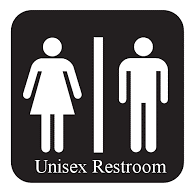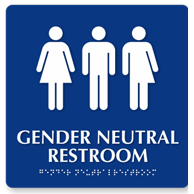All-Gender Restroom Ordinance FAQ
Download All-Gender Restroom Ordinance FAQ
-
What does the ordinance do?
This ordinance applies to single-occupant restrooms in public places in Seattle. This ordinance amends the Seattle Municipal Code to create all-gender single occupant restrooms. The measure applies to existing and newly-built City facilities, as well as public places in Seattle. It allows use of single occupant restrooms by any person, regardless of sex or gender identity, and prevents those restrooms from being restricted to a specific sex or gender identity. Restroom facilities without appropriate signage already in place will require new signs to be posted. The deadline for posting new signage is March 9, 2016. -
What is a public place?
A public place or “place of public accommodation” is any place where the public can gather or go, including venues such as hotels, restaurants, bars, public restrooms and elevators, shops and other retail establishments, theaters and cinemas, concert halls, sports stadiums, etc. Please call the Office for Civil Rights if you have questions about your business. For a full definition or public place, see All-Gender Restroom Ordinance → -
What are all-gender restrooms?
All-gender restrooms are facilities that anyone can use regardless of gender. They can be single or multi-stall. All-gender restrooms benefit a variety of people, including transgender and gender non-conforming individuals, people who require the assistance of a caregiver of a different gender, and parents with children of a different gender. The ordinance’s requirement to use all-gender signage only applies to single occupant restrooms. -
Why are they important?
Everybody has basic needs, including using a restroom. Trans and gender nonconforming people often face barriers when trying to access restroom facilities. This ordinance helps create safer, more accessible spaces for everyone.- SAFETY: Transgender and gender non-conforming people experience harassment, humiliation, denial of access, and physical violence in public restrooms.
- RACE: In a study by the Williams Institute that surveyed transgender and gender non-conforming people in San Francisco, transgender people of color reported harassment and other problems when using restrooms at much higher rate than white respondents.
- HEALTH: The same study found that 54% of respondents in Washington D.C. reported health problems from having to avoid using public restrooms, including dehydration, urinary tract infections, kidney infection and other kidney-related problems.
- BENEFITS EVERYONE: Creating more all-gender restrooms makes life easier for people with disabilities who require the help of an attendant, and helps parents with children of a different gender.
-
Will this ordinance impact multi-stall restrooms in Seattle?
The new signage requirement applies only to single-occupant restrooms – i.e. restrooms that are designed for use by one person at a time. However, the Ordinance does apply to multi-stall restrooms insofar as it protects an individual’s right to use the gender-specific facility (including restrooms) that corresponds to their gender identity. -
How will this ordinance be enforced?
The Seattle Office for Civil Rights (SOCR) is responsible for enforcing the ordinance, beginning 180 days from the ordinance' effective date. Members of the public will be able to notify SOCR of non-compliant restrooms, and SOCR will work with businesses to bring their restrooms into compliance. -
What other cities/jurisdictions have passed similar laws?
The City of Philadelphia and Multnomah County in Oregon have passed legislation mandating all-gender restrooms in city or county-controlled buildings. Washington D.C. and the City of West Hollywood have passed laws requiring gender neutral signage on all single-occupant restrooms in public places. -
What is appropriate signage?
Signage should be permanent and clearly indicate that the restroom is open to all genders, including but not limited to:
- All-Gender Restroom
- Gender-Neutral Restroom
- Unisex Restroom
- Toilet
- WC = Water Closet



-
What if my business uses specially ordered signs that require time to make? Can I get an extension?
No extensions will be granted. The ordinance allows business 180 days to voluntarily comply after the effective date of the ordinance, which was on August 14, 2015. All businesses must have appropriate signage as of March 9, 2016. If a business cannot post its branded/specially-made sign prior to that date, the business must post interim appropriate signage.Need a temporary sign? Download our postcard!
-
What if a business posts offensive or derogatory restroom signage?
Signs that are offensive or derogatory and based on someone’s protected class (sexual orientation, gender identity, race, age, etc.) may violate public accommodation discrimination laws. Please contact SOCR at (206) 684-4500 or file a complaint online. -
What if I am not allowed access to a multi-stall single-gender restroom that is consistent with my gender identity?
Under SMC 14.06, public places cannot deny people’s rights to use gender-specific restrooms and other gender-specific facilities that are consistent with their gender identity or expression. If you experience this, please contact SOCR at (206) 684-4500 or file a complaint online. -
What are the consequences to a business that is not in compliance?
Any business determined to be non-compliant will be sent an advisory letter. If the business does not comply within 30 calendar days, it will be subject to civil penalties. -
Can I appeal the civil penalty?
- A respondent may appeal a civil penalty by requesting a contested hearing before the Hearing Examiner in writing within 15 days of the date of the notice of violation and issuance of a civil penalty.
- If a respondent fails to timely appeal a civil penalty, the civil penalty shall be final and enforceable.
-
Must I remove gender-specific artwork (that is used for signage)?
According to the ordinance, single-occupant restrooms must not be restricted to use by a single gender. To that end, artwork that restricts the use of a restroom to a single gender is not permitted. -
When does SOCR start taking reports about signs that are out of compliance?
SOCR started taking reports on March 9, 2016. -
How do I report a bathroom that does not have the correct signage?
There are three ways to make a report.- Tweet #AllGenderRestroomSEA with a photograph of the signage and name and location of the business
- Submit a report through our complaint system and send a photograph to ocr_intake@seattle.gov with the inquiry number that you are given or
- Call us at (206) 684-4500 with the name and location of the business and provide us with a photograph via email.
Last updated: 03/09/2016